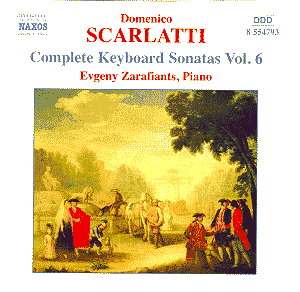Domenico Scarlatti
was born in 1785, the same year as Bach
and Handel, and studied in Naples with
his father Alessandro and in Venice
with Francesco Gasparini. In Venice,
indeed, he met Handel, who was in the
city to advance his understanding of
the Italian opera. Thereafter Scarlatti
travelled widely: he worked in Rome,
London, and Lisbon, before returning
home to Naples in 1725. Four years later
he moved to Madrid, where he lived for
practically all his remaining years.
Scarlatti is chiefly
famous for his five hundred and fifty
keyboard sonatas, a body of work which
developed the expressive range of this
musical genre to an extraordinary degree.
In common with his exact contemporary
Bach, he wrote for the harpsichord with
such verve and imagination that his
music sounds equally well (if not better)
on the modern piano; indeed it has rightly
become a standard feature of the repertoire.
The structures of the sonatas are considerably
varied; the two featured here are both
single movements.
This is Volume 6 in
Naxosís Scarlatti project with various
pianists. Evgeny Zarafiants is an excellent
player, and his clear articulation and
lucid textures make a strong feature
of this pleasing CD. Just as in a recital
in the concert hall, making a compelling
start is important in a recorded recital.
That is exactly what Zarafiants does
here, aided by clear (if a little dry)
Naxos sound.
The first few sonatas
are particularly attractive and nicely
contrasted, the slower tempo of the
second (in A major) offsetting the rhythmic
vitality of the first (in E major).
Therefore the temptation when listening
is to continue to the next item rather
than merely to listen to a single sonata.
The playing is particularly
precise and, just occasionally, this
can seem prosaic. For example, one of
the most appealing items in this collection
is the F major Sonata, K274, with its
delightfully pert rhythms. While there
is nothing particularly wrong with Zafariantsí
performance, the phrasing is a little
lacking in imagination and the result
is a certain lack of sparkle. One wonders
whether some Ė though not all - of this
music might sound better when played
on the composerís own instrument, the
harpsichord.
The recording too does
justice to Scarlatti, since it is dry
and clear though not without atmosphere
and warmth. This is probably an appropriate
balance, since it allows the details
of the musicís extraordinary textures
to be heard without difficulty. With
so many sonatas to his credit, it is
inevitably tempting to think that Scarlatti
composed merely to a formula. But nothing
could be further from the truth, and
this imaginatively planned disc serves
his music well.
Terry Barfoot


